Dover Castle › Toilets in a Medieval Castle » Ancient origins
Articles and Definitions › Contents
- Dover Castle › Antique Origins
- Toilets in a Medieval Castle › Ancient History
Ancient civilizations › Historical and archaeological sites
Dover Castle › Antique Origins
Definition and Origins
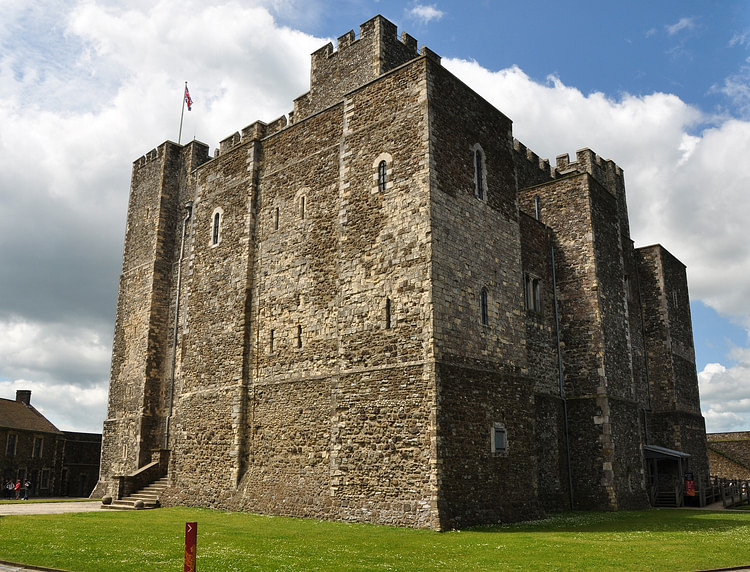
Dover Castle, located in the southern county of Kent, is one of the largest castles in England and one of the first to have concentric defensive walls. First built in 1066 CE by William the Conqueror to help prevent anyone repeating his own invasion, the castle was largely rebuilt in stone and a massive keep added by Henry II in the latter half of the 12th century CE. Despite its fine defences, the castle did not put off attackers and was famously, if ultimately unsuccessfully, besieged in 1216 CE by Prince Louis of France.
WILLIAM THE CONQUEROR
Dover Castle was first constructed by William I (aka William the Conqueror, r. 1066-1087 CE). The Norman king built many other castles such as at Windsor and the Tower of London because he needed both to cement his new regime and provide a network of secure abodes as he toured his realm. Understanding that an awe-inspiring castle was as good a way as any to impress upon the locals and foreigners alike of his intentions, William spared no expense in his building projects. Dover was a prime example of the Norman king's strategy, set in a strategically important position on a rise overlooking the straits of Dover and near the vital ancient road to Canterbury. The site of Dover castle had already caught the eye of previous builders and had been used from the Iron Age as a fort, by the Romans in the 1st century CE as the location of a lighthouse, and there was a Saxon church of Saint Mary there, built c. 1000 CE. The castle was built quickly and probably consisted of a wall enclosed tower made from wood with earthworks, but it was needed almost immediately when William's former ally, Eustace of Boulogne, attacked it in 1067 CE. The castle withstood its first test admirably and Eustace fled the country.
THE CASTLE KEEP WAS PROTECTED BY TWO CIRCUITS OF TOWERED WALLS & A PERIMETER DITCH & BARBICAN.
12TH-CENTURY REBUILDING
Most of William's earthworks and wooden defences have now been lost or built over, and what can be seen today largely dates to the 12th century CE and the long reign of Henry II (1154-1189 CE). From around 1170 CE to the late 1180's CE Henry II added important new features, transforming the castle by adding the inner ward (aka bailey or courtyard) with its massive stone keep and a towered curtain wall. The castle was innovative, probably being the first concentric example in Europe so that the heart of the castle, the keep (or donjon, the term used at the time of construction), was thus protected by two circuits of towered walls and a perimeter ditch and barbican - a fortified wall to protect a gate - which in Dover's case had a horizontal swing bridge that pivoted into a ditch, thus blocking the access.
The outer walls of the castle incorporated 14 rectangular towers set on projecting plinths, which had multiple functions: to protect the wall itself from excavation by the enemy, make their scaling more difficult, and to provide an unpredictable bounce of objects hurled down from the top of the wall. Incorporated into the outer wall was an Avranches Tower (a two-storey firing platform in a polygonal form) with multiple narrow windows for archers and crossbowmen.
There were two gateways: the King's Gate to the north and the Palace Gate to the south (probably not original names). Each gate took up a narrow space set between two towers, which is the earliest known use of twin-tower gates in Britain. The gates were each additionally protected by a barbican consisting of two walls to form an echelon overlooking a pit. If attackers broke through the perimeter wall they would still have difficulties getting to the inner wall as the ward and keep were further protected and isolated from the rest of the castle complex by a surrounding ditch. Henry also added a perimeter defensive wall at the northern end of the complex and a higher wall and embankment to surround the old church, bringing it within the castle proper.
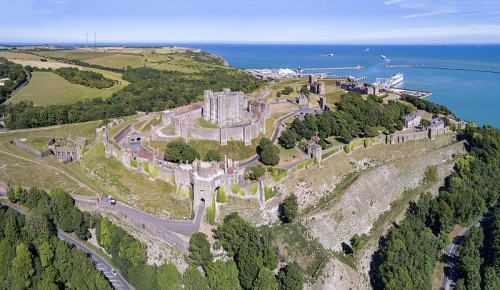
Dover Castle
The impressive keep was surrounded by its circuit-wall punctuated by towers with a double-towered gate connected to the outer wall by a narrow stone bridge and further protected by its own towered barbican. This towered entrance building had a basement which was accessed via a passage with three doors for added security.
The keep took nine years to finish and was built using Caen ashlar dressed stone over a core of local ragstone rubble.Constructed on a plinth, it measures some 25.3 metres (83 ft) in height while each side is around 29.5 metres (97 ft) in length.It is one of the largest such structures in England. The massive walls, supported by a central pilaster buttress in each centre, measure up to 6.4 metres (21 ft) in thickness. Inside, spiral staircases were built in two of the four corners. The entrance was on the first floor (ie above the ground floor) and, as was typical of the period, was probably accessed via a wooden staircase on the outside of the tower which could be removed when necessary to impede the enemy. At Dover Castle, this staircase was protected by the towered entrance structure or forebuilding.
INSIDE THE KEEP COMPLEX THERE WAS A WELL-CHAMBER TO ACCESS FRESH WATER WITH A SHAFT SINKING OVER 73 METRES (240 FT).
Inside the keep complex, there was a well-chamber to access fresh water with a shaft sinking over 73 metres (240 ft). There was also a cistern in the courtyard for collecting rainwater which was then run off via lead pipes into the keep itself. It was here in the keep that the king had his chambers when in residence along with an audience hall, latrines, and a chapel with an additional private entrance from the royal suites.
The cost of the building project was a massive 6,300 pounds. Records show, for example, that Maurice the Mason, who already had castle-building experience at Newcastle, received 8 pence per day in wages while he supervised the construction, which was the same as a knight. Maurice must have worked well for his salary was subsequently raised to a shilling (12p) a day.
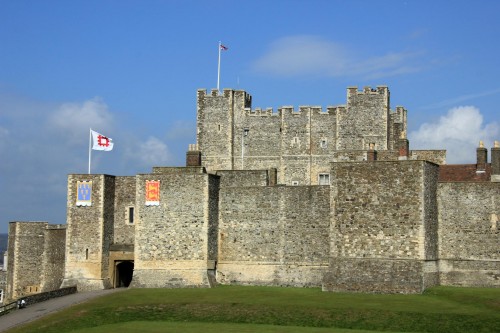
Inner Wall & Donjon, Dover Castle
The perimeter wall, after an interruption, was finally finished off by King John (r. 1199-1216 CE), who sunk another 1,000 pounds into the castle. He added several new D-shaped towers to the outer wall which gave a clearer field of fire without the blind spots of cornered towers. Rounder towers were also more stable structurally and so could better resist mining at their base, and they could better deflect heavy missiles launched by catapults. John added several domestic buildings, too, between 1207 and 1214 CE.
To ensure a suitable defence if required, local barons were expected to provide guards on a rotation basis. These came from anywhere in the southeast of England, such was the castle's importance to the king. One baron was made constable of the castle, again a role which rotated, and some of the castle's towers are named after these local lords. In the 13th century CE, after concerns were raised that a rotating force might not be as reliable or well-trained as a permanent garrison, the barons were, instead, required to put up the cash to maintain such a force. Local estates were also expected to regularly provide food provisions for the castle's needs, which included large reserves of wheat, barley, oats, fish, and wine.
THE SIEGE OF 1216 CE
After all this spending it must have been especially disappointing when the castle was breached during a siege by the French and English barons in 1216 CE. The attack, led by Prince Louis of France (the future King Louis VIII, r. 1223-1226 CE), came as something of a surprise - despite the fact that Louis had successfully attacked the castle at Rochester a few months earlier - and King John only just managed to have the justiciar, Hubert de Burgh, block himself in with 140 knights and suitable provisions.
The attackers camped to the north-east of the castle and concentrated on the northern outer gate as their most likely point of entry. The gate was protected by a barbican wall, but this was made of timber and so presented a good target for Louis' artillery. Amongst the formidable French catapults was one giant stone-thrower nicknamed “Bad Neighbour' ( Malvoisin ). Next, a siege tower was constructed with a covered platform bridge to stretch over the battlements of the outer walls. At the same time as attacking from above, sappers were busy tunnelling at the base of the gate tower's walls to undermine them and cause their collapse. Naturally, the defenders were not simply gawking at this spectacle of siege warfare and several sorties of knights were sent out to harass the attackers and countermines were dug so as to intersect those of the attackers.
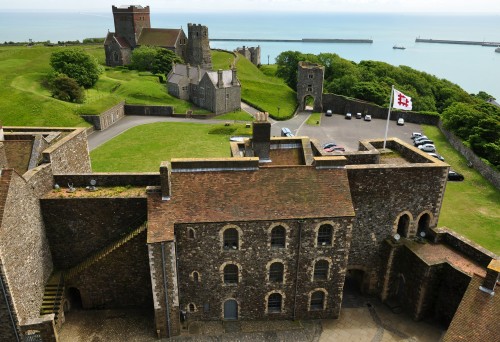
South View From Dover Castle
Eventually, Louis' forces did break through and into one of the towers of the gate which partially collapsed, but the defenders managed to fight back and were able to block up the narrow breach with timber and rubble. Louis' supply train was then attacked by a force coming from the Weald and a truce was called. A few months later, at the battle of Lincoln in 1217 CE, Sir William Marshal led the king's army to victory against Louis and his alliance of rebel English barons. The siege of Dover was thus abandoned, but it had been a near thing. The castle had been saved by political events elsewhere, and it clearly needed its defences bolstering. Thus, after the siege, the fortifications were improved to prevent a repeat occurrence, notably a better-protected outer gate by shifting it westwards and out of line with the gate of the inner wall. The main gate now had the two Norfolk Towers around it - what became the five-towered Constable's Gate, with is separate barbican across a ditch. At the same time, an extension of the curtain wall was made right up to the cliff edge. Finally, in the 1220s CE tunnels were excavated under the castle so that men could come and go secretly and launch surprise attacks in the case of a siege.
LATER ADDITIONS & ALTERATIONS
From around 1365 CE the castle was fitted with cannons and more appropriate circular windows added. In the 15th century CE various alterations were made such as roofing the forebuilding of the keep with its three towers - originally it was thought a roof might shelter attackers - and adding the Treasurer's Tower. In the same century, rectangular windows were created in the keep itself. In the 16th century CE, the castle continued to be strategically important and Elizabeth I (r. 1558-1603 CE) made a significant investment in its upkeep. Even later, in order to better accommodate artillery batteries, the walls of the inner ward were reduced in height and the battlements removed. In the 18th century CE, the gateways of the outer perimeter wall were modified and drawbridges added.
Toilets in a Medieval Castle › Ancient History
Ancient Civilizations
The medieval toilet or latrine, then called a privy or garderobe, was a primitive affair, but in a castle, one might find a little more comfort and certainly a great deal more design effort than had been invested elsewhere. Practicality, privacy, and efficient waste disposal were all considered and, even today, one of the most prominent and easily identifiable features of ruined medieval castles is the latrines which protrude from their exterior walls.
NAMES
Medieval toilets, just as today, were often referred to by a euphemism, the most common being 'privy chamber', just 'privy' or 'garderobe'. Other names included the 'draught', 'gong', 'siege-house', 'neccessarium', and even 'Golden Tower'. Garderobe later came to mean wardrobe in French, but its original meaning was likely just any small cupboard or room and, as space was at a premium in a castle, the toilets were never any bigger than absolutely necessary.

Medieval Castle Latrine
EXTERIORS
The toilets of a castle were usually built into the walls so that they projected out on corbels and any waste fell below and into the castle moat. Even better, waste went directly into a river as is the case of the latrines of one of the large stone halls at Chepstow Castle in Wales, built from the 11th century CE. Some castles, such as the 11th-century CE Corfe Castle in Dorset, England had latrine shafts emptying directly in the courtyard or bailey while still others hung conveniently over a cliff face, as at Peveril Castle in Derbyshire, England, built in 1176-1777 CE.
AT COITY CASTLE IN WALES, THERE WERE THREE TIERS OF TOILETS WITH THE SHAFTS EMPTYING INTO THE SAME COURTYARD BASEMENT.
The protruding shaft of masonry that made up the toilet was buttressed from below or might nestle in the junction between a tower and wall. Some waste shafts were short while others reached almost to the ground. In the latter case, that might prove a dangerous design feature if there were a siege of the castle. Indeed, besiegers used just such a latrine shaft in 1203-4 CE to gain entry to Chateau Gaillard on the River Seine in France, built by Richard I (r. 1189-99 CE) at the end of the 12th century CE. After the siege, to ensure no repeat of the trick, a masonry wall was built around the shaft exit.
Another design was to have tiers of toilets on the outside wall where the shafts all sent waste to the same collection point.Dover Castle, built in the second half of the 11th century CE, had a cesspit at the base of one wall of the keep to collect waste from the toilets above. At Coity Castle in Wales, built in the 12th century CE, there were three tiers of toilets with the shafts emptying into the same courtyard basement. The same arrangement was found at Langley Castle in Northumberland, England, built c. 1350 CE, with the common collection point being a pit which was cleaned out by a natural stream. There were also toilets in ground floor buildings and these had stone drainage channels to drain away waste. Waste from such collection points, or the ditch in general, was likely collected by local farmers to be reused as fertiliser. When castles became larger and more comfortable from the 14th century CE, so the number of conveniences increased. Bodiam Castle in East Sussex, England, for example, had no fewer than 28 toilets emptying out into its moat.
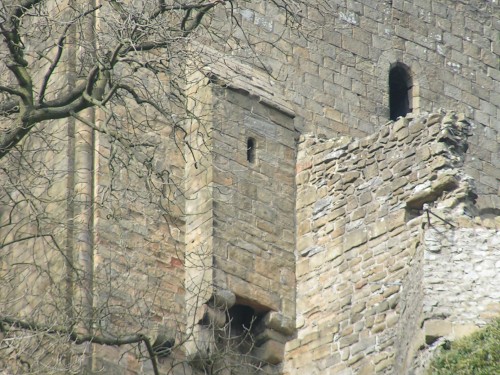
Garderobe, Peveril Castle
INTERIORS
Viewed from the interior, the toilet was set back in a recess or within a mural chamber (a passage within a wall) but not all were given the luxury of a wooden door. A short narrow passageway sometimes led to a toilet, often with a right-angle turn for greater privacy. Pairs of toilets, separated by a wall, were not uncommon and these might share the same waste chute. The chamber of the castle's lord often had a private latrine but even he had, like everyone else, a chamber pot if needed. The castle's priest might also be one of the lucky few to have an en-suite toilet for his own chamber, as at Northampton Castle, England, built in the late 11th century CE. Another sure place to find a castle toilet was in the corner of the Great Hall where audiences and banquets were held.
The toilet seat was made of a wooden bench covering the shaft hole in the masonry. The wood was usually cut with a rectangular or keyhole aperture. Hay, grass, or even moss were used as toilet paper. Toilet hay is referred to by medieval writers, albeit indirectly. Jocelin de Brakelond, the 12th-century CE English monk, recounted the story that a fire had almost broken out in the Abbey of Bury St. Edmonds when a candle had burned dangerously close to the hay in one of the abbey's privies.
Some toilets had a window to let in fresh air, which for the same reason was not shuttered like other windows of a castle. The floor may have been scattered with rushes and aromatic herbs and flowers, just as the Great Hall of the castle was, to deter vermin and offer a more pleasant fragrance than the users could provide. Walls were sometimes whitewashed with a coating of lime-plaster which maximised the light coming from the small window and because lime kills off bacteria.
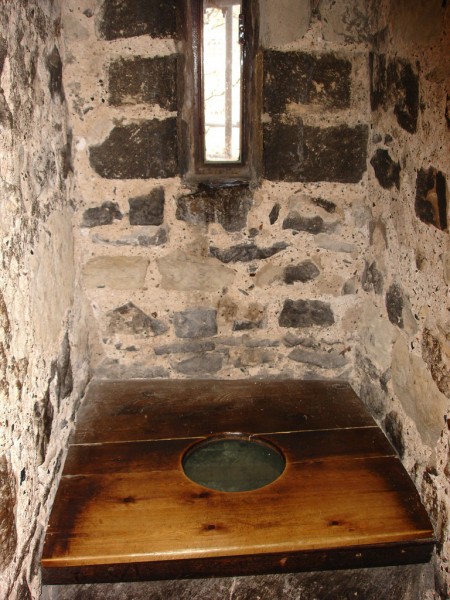
Toilet, Tower of London
The toilet was cleaned either by a simple bucket of water thrown down the shaft or by diverting the wastewater from the kitchen sinks. More rarely, rainwater was diverted from gutters above the latrine which might also be collected into a cistern and then periodically opened to flush the toilet shaft. Despite these refinements, there can be no doubt that a castle toilet stank to high heaven. Indeed, it was not uncommon to hang clothing near latrines as the pungent ammonia fumes helped to kill mites. Henry III of England (r. 1216-1272 CE) famously made mention of the problem of unsavoury odours in a letter to one of his castle constables, ordering a no-expense-spared refit of the amenities of the Tower of London:
Since the privy chamber…in London is situated in an undue and improper place, wherefore it smells badly, we command you on the faith and love by which you are bounden to us that you in no wise omit to cause another privy chamber to be made…in such more fitting and proper place that you may select there, even though it should cost a hundred pounds, so that it may be made before the feast of the Translation of Saint Edward, before we come thither. (Gies, 73)
URINALS
Triangular urinals were built into some tower walls so that defenders did not have to leave their post for very long. An example is to be found in the mural passage at Orford Castle in Suffolk, England, built in the second half of the 12th century CE. It seems that even such basic human activities were considered by architects to provide the best possible defence of the castle against all comers in all situations. Intriguingly, at Castle Rising in Norfolk, England, built in the mid-12th century CE, there are two toilets next to each other but in separate rooms, one with a toilet and one with a urinal which might perhaps be evidence of a separation of the sexes.
LICENSE:
Article based on information obtained from these sources:with permission from the Website Ancient History Encyclopedia
Content is available under License Creative Commons: Attribution-NonCommercial-ShareAlike 3.0 Unported. CC-BY-NC-SA License